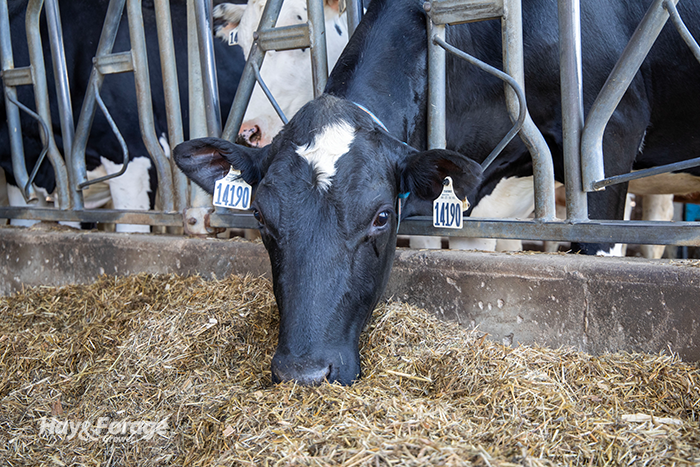Creative feed solutions span the US |
| By Amber Friedrichsen, Associate Editor |
|
|
 Livestock systems across the country are ultimately anchored in the forage and feedstuffs available to them. Even as advances in the agricultural industry allow more opportunities for farms to expand and diversify, the strength and sustainability of a feeding program will always be the foundation of a successful operation. Aspects of dairy production — especially dairy ration formulation — can be highly dependent on an area’s predominate forage species, forage availability, and the length and volatility of a growing season. If even one of these factors is compromised, there could be detrimental impacts to animal health and milk production. Navigating forage shortages and utilizing unlikely feedstuffs was one of the topics presented at last week’s Professional Dairy Producers Business Conference in Wisconsin Dells, Wis. Two dairy consultants from distinctly different regions compared how their clients construct creative feeding plans with the forages and supplemental ingredients that are available to them in the face of unfavorable environmental and economic conditions. Scarcity in the South Bill Reyes is a nutrition and management consultant with Royal Ag Services in the southwest United States. He works with 16 dairies across Texas, Oklahoma, Kansas, and New Mexico where dry and unpredictable weather patterns have defined most of the growing seasons over the past two decades. “I’ve been [in the Southwest] for 18 years, and only four of those years have we had enough rain to make a good crop,” Reyes said. “The other 14 years, we may not have always been considered in a drought, but we got rain at the wrong time of year to make a good crop.” Ideally, forage makes up 50% to 60% of the dairy rations Reyes formulates for his clients, but he said inclusion rates have hit as low as 28% when forage was scarce. This happens more often than he would like considering the region’s challenging climate; however, Reyes said feeding emergency diets is the only alternative to selling or relocating dairy cattle in such situations. He noted many dairy producers in the Southwest fall back on native prairie grasses, including what is enrolled in the Conservation Reserve Program (CRP), when primary forage supplies are insufficient. Despite a decline in quality, Reyes said utilizing native grasses may be the best-case scenario to maintain dairy production during difficult times — as long as the forage is free of weeds and other foreign objects. One problem with feeding native prairie grasses — and other less palatable species — is that cows will likely sort out and refuse the forage. For this reason, Reyes suggested grinding native grass smaller than the typical forage particle size to ensure cattle can’t separate it from the rest of the ration. “No matter the feed ingredient, it’s all about presentation,” he asserted. “At the end of the day, it might not be what cows want to eat, but if that’s what you have to feed them, you have to present it in a way that they will consume it.” Economics in the Northeast A different set of circumstances prompts dairy farmers from the northeastern part of the nation to get creative with their feeding plans. Joseph Bender with the University of Pennsylvania said balancing forage with alternative feedstuffs and by-products in dairy rations is more of a matter of economics than availability in the Keystone State. Despite being half forage and half starch from a nutritional standpoint, corn silage dominates dairy rations on many of the farms that Bender visits to collect field research. In fact, he noted his most profitable clients feed their lactating herd more than 20 pounds of corn silage per cow per day on a dry matter basis. Other common forage sources among Bender’s clients include triticale and ryegrass; however, the fiber digestibility of these species can become a limiting factor for animal intake, and thus, milk production. Therefore, allocating a larger portion of the diet to commodity feeds helps cows reach their energy needs more cost-effectively. Bender mentioned that high farmland values in his state of Pennsylvania influence forage inclusion rates in dairy rations, too. For example, it is more profitable for some producers to rent land for only a percentage of their feed needs and leverage more space in their budget for by-products instead of buying crop ground. Wet brewers grains is one by-product in particular that Bender said is widely available and can offer high returns when replacing homegrown forages in animal diets. With that said, being near many food processing facilities warrants a unique list of ingredients that can be added to dairy rations, including discarded bakery products, waste from the Hershey’s Chocolate factory, and even ketchup. “I have a farm feeding chickpea flour right now that is 58% starch,” Bender added. “Another farm I work with has a trucking company and hauls potatoes. The potatoes that don’t make it to processing go to their heifers.” Although farmland is much less expensive in the Southwest, Reyes said dairy producers there are facing competition with large corporations that are investing in more and more acreage. Cotton production poses another roadblock to acquiring enough land for forage as more fields are being dedicated to the high-value annual cash crop. And since there are fewer food processing facilities in the South compared to the Northeast, producers are limited to lower quality, less palatable by-products to supplement dairy diets, such as cottonseed meal and sunflower meal. Regardless of the region, extreme weather events and rising production costs will likely continue to challenge dairy producers when it comes to formulating rations. Reyes and Bender agreed there is no single solution to overcoming these obstacles, but exploring different forage and feedstuff options could help alleviate some of the pressure on production. |
